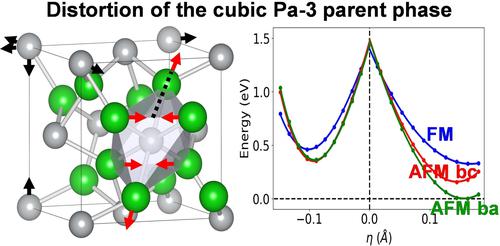当前位置:
X-MOL 学术
›
Chem. Eur. J.
›
论文详情
Our official English website, www.x-mol.net, welcomes your feedback! (Note: you will need to create a separate account there.)
New Ideas for Understanding the Structure and Magnetism in AgF2: Prediction of Ferroelasticity
Chemistry - A European Journal ( IF 4.3 ) Pub Date : 2021-07-23 , DOI: 10.1002/chem.202101865 Jose Antonio Aramburu 1 , Inés Sánchez-Movellán 2 , Jorge Moreno-Ceballos 3 , Pablo García-Fernández 2 , Miguel Moreno 1
Chemistry - A European Journal ( IF 4.3 ) Pub Date : 2021-07-23 , DOI: 10.1002/chem.202101865 Jose Antonio Aramburu 1 , Inés Sánchez-Movellán 2 , Jorge Moreno-Ceballos 3 , Pablo García-Fernández 2 , Miguel Moreno 1
Affiliation

|
In the search for new high-temperature superconductors, it has been proposed that there are strong similarities between the fluoroargentate AgF2 and the cuprate La2CuO4. We explored the origin of the possible layered structure of AgF2 by studying its parent high-symmetry phase and comparing these results with those of a seemingly analogous cuprate, CuF2. Our findings first stress the large differences between CuF2 and AgF2. Indeed, the parent structure of AgF2 is found to be cubic, naturally devoid of any layering, even though Ag2+ ions occupy trigonal sites that, nevertheless, allow the existence of a Jahn-Teller effect. The observed Pbca orthorhombic phase is found when the system is cooperatively distorted by a local E⊗e trigonal Jahn-Teller effect around the silver sites that creates both geometrical and magnetic layering. While the distortion implies that two Ag2+−F− bonds increase their distance by 15 % and become softer, our simulations indicate that covalent bonding and interlayer electron hopping is strong, unlike the situation in cuprate superconductors, and that, in fact, exfoliation of individual planes might be a harder task than previously suggested. As a salient feature, these results prove that the actual magnetic structure in AgF2 is a direct consequence of vibronic contributions involved in the Jahn-Teller effect. Finally, our findings show that, due to the multiple minima intrinsic to the Jahn-Teller energy surface, the system is ferroelastic, a property that is strongly coupled to magnetism in this argentate.
中文翻译:

理解 AgF2 结构和磁性的新思路:铁弹性预测
在寻找新的高温超导体的过程中,有人提出氟银 AgF 2和铜酸盐 La 2 CuO 4之间存在很强的相似性。我们通过研究其母高对称相并将这些结果与看似类似的铜酸盐 CuF 2 的结果进行比较,探索了 AgF 2可能的层状结构的起源。我们的发现首先强调了 CuF 2和 AgF 2之间的巨大差异。事实上,发现AgF 2的母体结构是立方体,自然没有任何分层,即使 Ag 2+离子占据三角位置,但允许存在 Jahn-Teller 效应。当系统被银位点周围的局部 E⊗e 三角 Jahn-Teller 效应共同扭曲时,会发现观察到的Pbca正交相,从而产生几何和磁性分层。虽然失真意味着两个 Ag 2+ -F -键的距离增加了 15% 并变得更软,但我们的模拟表明共价键和层间电子跳跃很强,与铜酸盐超导体的情况不同,事实上,剥离单个飞机的任务可能比之前建议的更困难。作为一个显着特征,这些结果证明 AgF 2中的实际磁结构是涉及 Jahn-Teller 效应的振动贡献的直接结果。最后,我们的研究结果表明,由于 Jahn-Teller 能量表面固有的多个最小值,该系统是铁弹性的,这种特性与该银酸盐的磁性强耦合。
更新日期:2021-09-24
中文翻译:

理解 AgF2 结构和磁性的新思路:铁弹性预测
在寻找新的高温超导体的过程中,有人提出氟银 AgF 2和铜酸盐 La 2 CuO 4之间存在很强的相似性。我们通过研究其母高对称相并将这些结果与看似类似的铜酸盐 CuF 2 的结果进行比较,探索了 AgF 2可能的层状结构的起源。我们的发现首先强调了 CuF 2和 AgF 2之间的巨大差异。事实上,发现AgF 2的母体结构是立方体,自然没有任何分层,即使 Ag 2+离子占据三角位置,但允许存在 Jahn-Teller 效应。当系统被银位点周围的局部 E⊗e 三角 Jahn-Teller 效应共同扭曲时,会发现观察到的Pbca正交相,从而产生几何和磁性分层。虽然失真意味着两个 Ag 2+ -F -键的距离增加了 15% 并变得更软,但我们的模拟表明共价键和层间电子跳跃很强,与铜酸盐超导体的情况不同,事实上,剥离单个飞机的任务可能比之前建议的更困难。作为一个显着特征,这些结果证明 AgF 2中的实际磁结构是涉及 Jahn-Teller 效应的振动贡献的直接结果。最后,我们的研究结果表明,由于 Jahn-Teller 能量表面固有的多个最小值,该系统是铁弹性的,这种特性与该银酸盐的磁性强耦合。


























 京公网安备 11010802027423号
京公网安备 11010802027423号